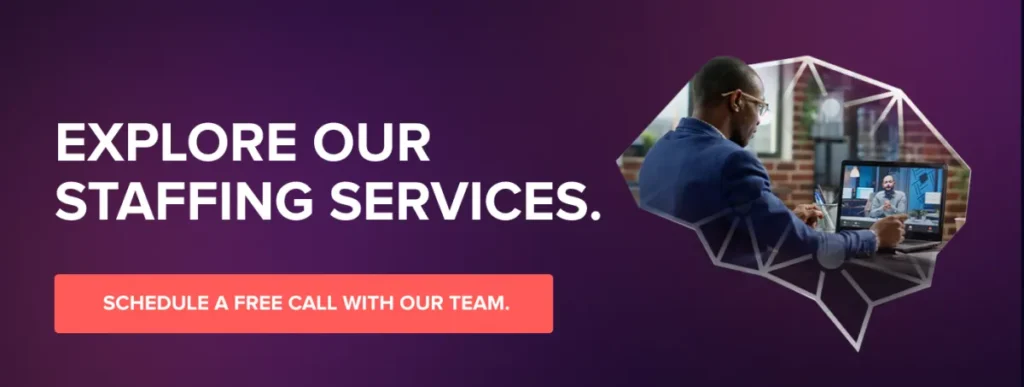Introduction

Visualize stepping into the dynamic world of Agile Project Management—a realm where flexibility meets functionality, and change is not only expected but embraced. In today’s fast-paced business landscape, where market conditions shift with dizzying speed and technology evolves by the minute, maintaining a competitive edge means being able to pivot quickly and efficiently. This is where Agile Project Management shines, offering organizations the toolkit they need to adapt swiftly to these changes.
For employers focused on securing the finest job description template available—one that can serve as a solid foundation for crafting your own hiring specifications—look no further. Click the link below for a complimentary download of our Agile Project Manager Job Description. This template embodies the core principles and best practices of C9Staff’s renowned hiring methodology, ensuring you start with a robust framework tailored to attract and hire the top talent in the industry.
Agile Project Manager Job Description Template

Agile is more than just a methodology; it’s a critical lifeline in the corporate world, enabling businesses to respond rapidly to feedback and pursue continuous improvement in real time. By breaking projects into manageable units, prioritizing direct communication, and fostering an environment of regular reflection and adaptation, Agile empowers teams to achieve more predictable outcomes and deliver value to their customers faster and more frequently.
As we dive into the specifics of crafting the perfect Agile Project Manager job description, our goal is to go beyond merely filling a position. We aim to attract visionary leaders capable of steering complex projects to success while navigating the nuanced challenges of their industries. This article is designed not just to inform but to transform your approach to recruitment. By the end, you will be equipped with all the knowledge necessary to draft a job description that not only attracts top talent but also aligns with the highest industry standards.
Join me as we board on this detailed journey, exploring each key element that makes an Agile Project Manager indispensable to modern business success. Let this guide empower you to craft a job description that captures the essence of what it truly means to lead in the realm of Agile project management.
Master Agile Project Management: A Complete Tutorial for Success | Simplilearn
Understanding the Agile Project Manager Role

Let’s explore deep into the realm of Agile Project Management. At its core, Agile Project Management is a methodology that emphasizes flexibility, iterative progress, and team collaboration. Unlike traditional project management approaches which often follow a linear path, Agile promotes adaptive planning, evolutionary development, and continuous improvement, all while encouraging rapid and flexible response to change. This makes it ideally suited for projects where requirements and solutions evolve through collaboration between self-organizing cross-functional teams.
The key responsibilities of an Agile Project Manager (APM) revolve around facilitating these core principles in everyday practice. An APM orchestrates daily stand-ups, which are brief meetings designed to align team efforts and plan daily activities. They manage the product backlog, which is a prioritized list of project deliverables, to ensure that team effort is directed towards the most valuable project outcomes. Perhaps most importantly, they foster an environment where continuous feedback is not just encouraged but is a cornerstone of the project’s process. This involves regular retrospectives where the team reflects on the past sprint and identifies improvements for future sprints.
Transitioning to the versatility and importance of Agile Project Managers across various industries, we see that this role is not confined to tech or software development. In healthcare, for example, Agile Project Managers have facilitated faster responses to changing regulations and patient needs. In finance, they enable quicker adjustments to new economic policies or market conditions. Meanwhile, in manufacturing, agility helps companies adapt to supply chain disruptions more swiftly.
For instance, a healthcare company might use Agile methodologies to develop new patient care software, where requirements can change drastically as end-user feedback is incorporated. In finance, Agile Project Management might be used to oversee a new mobile banking application, requiring rapid updates based on customer feedback and regulatory changes. In manufacturing, Agile practices can streamline the production process, allowing for quicker adaptation to new technologies or unexpected challenges.
By understanding the strategic value of Agile Project Managers, it becomes clear why such a position is crucial for modern organizations seeking agility and resilience. As we continue to explore the Agile Project Manager’s role, remember that their impact goes beyond mere project completion; they are pivotal in enhancing project delivery and achieving business objectives across all industries. This comprehensive understanding underscores the importance of crafting a job description that not only captures the essence of agility but also attracts the top talent capable of driving significant project success in this dynamic business environment.
Core Responsibilities of an Agile Project Manager

As you explore deeper into the critical role of an Agile Project Manager, it becomes clear that their responsibilities are pivotal for any organization aiming to thrive in today’s dynamic business environment. The Agile Project Manager’s day-to-day operations and strategic importance cannot be overstated, as they are central to planning, executing, and delivering projects successfully.
Project Planning and Execution
An Agile Project Manager is integral in planning sprints, which are short, consistent cycles in which specific project tasks are completed. They manage timelines meticulously, balancing flexibility with the discipline needed to meet project deadlines. This involves overseeing the project’s execution from inception to completion, adapting plans as projects evolve and requirements change. Their role ensures that the team not only meets deadlines but also achieves project goals effectively, making them indispensable in navigating the complexities of project management.
Team Leadership and Management
Leadership skills are crucial for managing diverse teams, and Agile Project Managers excel in creating and maintaining a collaborative environment. This environment is essential for the iterative and team-centric nature of Agile methodologies. By leading by example, Agile Project Managers promote open communication and encourage team members to voice their opinions and ideas. This openness is vital for fostering an inclusive atmosphere where conflict is not just resolved but used as a stepping stone for innovation and improvement, thereby maintaining high team morale and productivity.
Stakeholder Engagement
The role of an Agile Project Manager extends beyond the team to engaging stakeholders at various levels. They serve as the bridge between the project team and external stakeholders, including clients, team members, and upper management. By ensuring that all parties are aligned with the project’s objectives, progress, and changes, Agile Project Managers secure buy-in and facilitate smoother project delivery. This alignment is crucial for the successful implementation of project outcomes and for adapting to any changes in scope or strategy, thereby enhancing the project’s impact and relevance.
Essential Skills and Qualifications

As we dig further into the competencies that define top-tier Agile Project Managers, it’s essential to understand both the technical and soft skills that are crucial for success in this dynamic role. This section focuses on these skills and the qualifications that underline the expertise of accomplished Agile Project Managers.
Technical Skills and Software Proficiency
A proficient Agile Project Manager must master various technical skills and software tools that facilitate effective project management. Essential tools such as Jira, Trello, or Asana are staples in the Agile toolkit, enabling managers to track progress, manage tasks, and maintain continuous communication with team members. Additionally, an understanding of software development processes is crucial, even for managers outside the tech industry, as it helps in bridging the gap between technical teams and business objectives. This familiarity ensures that project goals align with technological capabilities and business strategies.
Soft Skills
Beyond technical abilities, the soft skills of an Agile Project Manager are what truly enable them to excel. Foremost among these is communication. Effective communication is the backbone of Agile methodologies, facilitating clear and constant interaction among team members and with stakeholders. This ensures that everyone is aligned with the project’s goals and progress. Flexibility is another critical soft skill; it allows Agile Project Managers to adapt to changes and challenges swiftly, ensuring that the project remains on track despite unexpected developments. Problem-solving skills are also paramount, as they empower managers to swiftly identify solutions and alternatives to keep the project moving forward.
Certifications
To further enhance their credentials, Agile Project Managers often pursue certifications that validate their expertise and commitment to Agile practices. Certifications such as Certified ScrumMaster (CSM) and PMI-Agile Certified Practitioner (PMI-ACP) are highly regarded. These certifications not only demonstrate a professional’s knowledge and ability to implement Agile practices but also their dedication to continuous learning and improvement. Holding such certifications signals to employers and teams that the manager is equipped with the tools and knowledge to lead and succeed in any project environment.
If you’re ready to supercharge your career and find your dream job, C9Staff is here to guide you every step of the way. We invite you to click the link below and submit your resume to our talent acquisition department. If your qualifications meet our client’s requirements, we will reach out to discuss potential opportunities that align perfectly with your career goals based on your resume. Don’t miss the chance to connect with top employers and take your professional journey to the next level.

Crafting the Job Description

Transitioning from understanding the Agile Project Manager’s role and qualifications to actual implementation, this section guides you through the art of crafting a compelling and effective job description. A well-crafted job description serves not just as a recruitment tool, but as a strategic document that aligns with company goals and the dynamism of Agile methodologies.
Components of an Effective Job Description
Begin by outlining the key components of a robust job description:
Role Summary: Start with a clear role summary that encapsulates the essence of the Agile Project Manager position. This summary should quickly inform potential candidates about the nature and importance of the role within the company.
Detailed Responsibilities: Follow the summary with detailed responsibilities that reflect the dynamic operations of an Agile Project Manager. Ensure these responsibilities clearly convey the daily activities and the strategic importance of the role in driving Agile projects.
Qualifications: List essential qualifications, including required skills and educational background. Be specific to help filter candidates who best fit the role.
Benefits: Mention the benefits that align with the company’s values and the nature of the job. This might include professional development opportunities, health benefits, and flexibility options which are important for attracting top talent.
Language and Tone
Next, delve into the language and tone to be used in the job description:
Reflect both the company’s culture and the agility of Agile methodologies. Use language that is inclusive and engaging, yet precise and professional, to attract a diverse range of top-tier candidates. Ensure the tone resonates with the dynamism and collaborative spirit expected in Agile environments.
SEO Keywords
Address the strategic use of SEO keywords:
Integrating relevant SEO keywords enhances the discoverability of the job description and targets the right demographic of job seekers. Use phrases such as “Agile Project Management,” “Scrum Master,” and “dynamic team leadership” to boost SEO.
Discuss techniques for seamlessly incorporating these keywords into the job description without compromising its readability or professional tone. This includes using keywords naturally within the role summary, responsibilities, and qualifications sections.
For employers focused on securing the finest job description template available—one that can serve as a solid foundation for crafting your own hiring specifications—look no further. Click the link below for a complimentary download of our Agile Project Manager Job Description. This template embodies the core principles and best practices of C9Staff’s renowned hiring methodology, ensuring you start with a robust framework tailored to attract and hire the top talent in the industry.
Agile Project Manager Job Description Template

Salary and Career Progression

As we continue to guide potential employers and candidates through the intricate process of crafting and responding to a job description for an Agile Project Manager, let us focus on two crucial aspects that significantly influence career decisions: compensation ranges and career progression opportunities.
Compensation Ranges
Begin by providing up-to-date salary benchmarks for Agile Project Managers. These compensation ranges vary based on industry, geography, and experience levels. For instance, Agile Project Managers in the technology sector in urban areas such as San Francisco or New York may command higher salaries compared to those in manufacturing sectors or in smaller cities. Discussing these variations helps employers set competitive salaries that attract the best candidates while also allowing candidates to gauge their market value effectively. This transparency ensures that expectations on both sides are well-aligned with industry standards, making the recruitment process smoother and more efficient.
Career Pathways
Next, outline the potential career pathways for Agile Project Managers. Illuminate the various advancement opportunities that can enhance the job’s attractiveness. For example, an Agile Project Manager may progress to senior management roles like Program Manager or Portfolio Manager. Alternatively, they might specialize in areas like Scrum Mastery or Product Ownership, which offer unique challenges and rewards. Emphasize the value of continuous professional development in the Agile field, highlighting how dedication to learning and adaptability can lead to significant roles within the organization or broader industry. This aspect of career progression is particularly appealing to ambitious professionals seeking not just a job but a dynamic career ladder.
Industry-specific Variations

As we navigate the diverse landscape of industries that employ Agile methodologies, this section highlights how the role of an Agile Project Manager adapts to different sector-specific demands. Understanding these variations is crucial for crafting job descriptions that attract the right talent and meet the unique needs of each industry.
Case Studies Across Industries
Technology Sector: In the fast-paced tech industry, Agile Project Managers play a pivotal role in fostering rapid iteration and continuous delivery. For instance, at a leading software development firm, Agile principles drive quick adaptations to technology changes and market demands. An Agile Project Manager here needs robust technical skills and a deep familiarity with DevOps tools to manage continuous integration and continuous delivery pipelines effectively.
Healthcare Sector: Contrastingly, in the healthcare sector, the emphasis shifts towards regulatory compliance and patient data security. A case study from a healthcare technology company illustrates an Agile Project Manager leading projects under stringent regulatory environments. This role requires exceptional skills in risk management and stakeholder communication, ensuring that patient care solutions not only meet clinical needs but also comply with healthcare regulations like HIPAA.
Finance Sector: In finance, Agile Project Managers must navigate a landscape defined by regulatory requirements and cost efficiency. A finance sector Agile Project Manager might focus on delivering projects that comply with financial regulations while optimizing cost management and improving client services. Their job description often highlights expertise in regulatory compliance, risk assessment, and financial forecasting.
Adapting the Job Description
With these case studies in mind, it’s evident that tweaking the job description based on industry-specific needs is essential. For technology sectors, emphasize skills like software development lifecycle management and technical acumen. In healthcare, highlight qualifications around compliance, patient privacy laws, and stakeholder engagement within a regulated framework. For finance, focus on risk management capabilities, understanding of financial regulations, and cost optimization.
Common Mistakes to Avoid

As you approach the final stages of crafting the perfect job description for an Agile Project Manager, it is crucial to ensure accuracy and legality in the document. This section highlights common pitfalls and legal considerations that are essential for crafting an effective and compliant job description.
Common Pitfalls in Job Descriptions
Firstly, a common error in drafting job descriptions is overgeneralizing the role or underestimating the required skills. To attract the right candidates and set clear expectations, it’s vital to specify the responsibilities and qualifications accurately. For instance, merely stating “responsible for project management” is too vague and could attract unqualified applicants. Instead, detailing that the role requires managing multi-disciplinary project teams using Agile methodologies to deliver specific outcomes ensures that candidates understand the depth and scope of the role.
Legal Considerations
Next, explore into the legal considerations necessary when drafting job descriptions. It is imperative to comply with employment laws, such as equal employment opportunity regulations, to avoid discriminatory practices. This involves careful phrasing of job requirements and benefits. For example, instead of requiring “physical presence at the office,” which could discriminate against individuals with disabilities, specify “ability to engage with team members during core business hours via in-person, phone, or video calls.” This language is inclusive and accommodates various working styles and needs.
Crafting Legally Compliant and Effective Descriptions
Conclude this section by underscoring the importance of these aspects in crafting a job description that is not only effective in attracting the right candidates but also compliant with legal standards. Your aim is to equip the reader with the knowledge to avoid common errors that could undermine their recruitment efforts or lead to legal challenges. Emphasize the need for HR professionals and hiring managers to stay informed about current employment laws and best practices in job description writing.
By adhering to these guidelines, organizations can ensure that their job descriptions not only attract qualified candidates but also promote a fair and inclusive hiring process. Use a direct and engaging tone to highlight the critical nature of these considerations, ensuring that the content not only informs but also instills a sense of responsibility in the reader to uphold the highest standards in job description writing. This approach not only enhances the quality of applicants but also protects the organization from potential legal issues, contributing to a more effective and equitable recruitment process.
If you’re looking to enhance your recruitment process for an Agile Project Manager, C9Staff is here to help. We invite you to click the link below and schedule a free exploratory call with one of our account managers today. During this call, we’ll carefully listen to your specific needs and provide endorsements for potential candidates at no cost, helping you evaluate the best talent available at competitive prices. Discover how C9Staff can assist you in sourcing, recruiting, hiring, training, managing, and deploying the ideal candidate for your organization.

Conclusion

As we wrap up this comprehensive guide, let’s revisit the essential elements that compose a top-tier Agile Project Manager job description. From understanding the Agile Project Manager role and its significance across various industries to detailing the core responsibilities, necessary skills, and qualifications, each component plays a crucial role in developing an effective job description. We’ve highlighted the importance of including specific technical skills, the right mix of soft skills, and relevant certifications that align with industry standards, ensuring that the description meets the dynamic demands of this pivotal role.
Moreover, we emphasized the strategic incorporation of salary and career progression information to attract and retain top talent, while also tailoring the job description to meet industry-specific requirements. We discussed the common pitfalls to avoid, such as overgeneralizing the role or underestimating the required skills, and touched on the legal considerations to ensure the job description not only attracts qualified candidates but also adheres to employment laws.
Now, I urge both employers and job seekers to utilize the guidelines provided to enhance their recruitment or job search strategies. Employers should focus on crafting clear, comprehensive, and legally compliant job descriptions that reflect the dynamic nature of the Agile Project Manager role. Job seekers, on the other hand, can use this information to evaluate job descriptions more critically and position themselves effectively for these roles.
I invite you to apply these insights to create job descriptions that not only fulfill the operational needs of your organizations but also promote a culture of agility and continuous improvement. Let this guide inspire you to take action, ensuring that you leave not just informed but also motivated to implement what you’ve learned. Together, let’s redefine industry standards and foster environments where agility and proactive leadership thrive.




